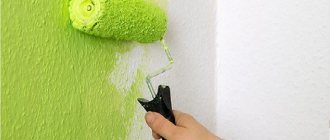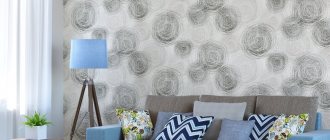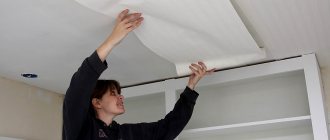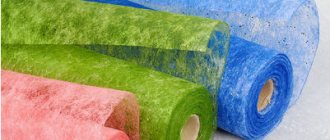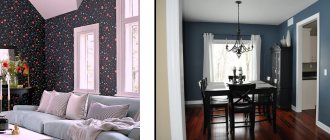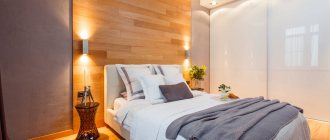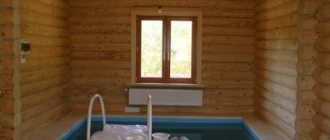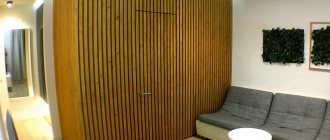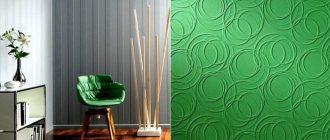Is it possible to glue wallpaper to uneven walls: features
Uneven walls are one of the main problems when renovating an apartment. The flaws can be minor, noticeable only in certain lighting. There may be clearly visible irregularities that can only be corrected with the help of professional finishers. Such walls cannot be painted, liquid wallpaper or decorative plaster must be applied; this type of finishing will only highlight the imperfections of the wall. The only option that is suitable for decorating walls with uneven surfaces is to use wallpaper. They will help visually align the walls and partially hide imperfections.
Liquid wallpaper - decorative plaster
On a large area of the wall, the use of liquid wallpaper is justified if there is a whole cloud of small defects. The liquid mixture will fill all cavities and slightly level out small bulges, but it is unlikely to cope with large problems.
Related article: Gazebo layout: various design options
Liquid wallpaper is wear-resistant and durable; in large, dirty rooms it will be an excellent wall covering.
Green decorative plaster
These are the options for choosing wallpaper for uneven walls, and finally we would publish a small set of rules for choosing a pattern and color.
What wallpaper to choose for uneven walls to hide unevenness and cracks
Irregularities on the walls will help hide the wallpaper:
- with a small pattern, for example, an ornament of plant elements, figurines of birds, animals;
- with an abstract design that does not have strict geometric shapes;
- with a textured pattern, any convex images, when properly glued, will make the wall more even. A convex pattern, both large and small, is suitable;
- with imitation of various types of plaster.
The pattern on wallpaper with a pattern should not be selected at the joints. This will increase the consumption of material and emphasize the unevenness of the wall if it falls under the joints of the strips.
Which ones highlight the flaws in plaster?
In this case, you should not use rolls:
- with a strict geometric pattern, especially with vertical or horizontal stripes;
- with light or pastel shades, they will make recesses or protrusions on the walls much more noticeable;
- thin paper-based ones will highlight even small imperfections in the plaster;
- on a thin base with a geometric pattern. When pasted onto defects, the pattern will be deformed and attract attention;
- plain rolls of light colors, for example, sand, pink, light green.
The thickest wallpaper for uneven walls
When choosing a suitable roll, you need to pay attention to the thickness of the material: the thicker it is, the better it will hide the imperfections of the walls.
The following wallpapers are suitable here:
- multilayer paper;
- non-woven fabric;
- vinyl, thanks to the coating they have a high density from 200 to 400 g/m2;
- from a natural base. They are made from plant materials, the most common being bamboo and cork. Thanks to their thickness and texture, they mask all the imperfections of the wall well. Can be used for one, the most problematic wall in the room.
Wallpaper made from natural materials is not cheap, but it does not emit harmful substances, is durable, and is easy to clean. Cork wallpaper provides sound insulation for the room.
Please note that the thicker the wallpaper, the more difficult it is to glue it. Therefore, if you have no experience in gluing wallpaper, you need to choose rolls with medium density.
Vinyl - durable and bright
Related article: How much do window blinds cost?
Vinyl wallpaper belongs to the more expensive segment of the wallpaper market. They are made in several versions, which to one degree or another satisfy the requirements of various rooms in an apartment or house.
Surface irregularities are not so noticeable on bright wallpaper
The thick structure and deep texture of vinyl allows you to hide more defects on the wall. In addition, vinyl is able to imitate the texture of natural finishing materials, which are not always available to us.
If we consider the huge group of wallpapers recommended for hanging on poor quality walls, then three areas stand out.
Foamed vinyl is the cheapest and simplest option, produced by a large number of domestic and foreign wallpaper factories. Due to the thickness of the canvas, wallpaper will perfectly hide defects on the surface, but the decorative coating itself is not the most durable and durable.
Texture of foam vinyl seen in detail
When choosing wallpaper for uneven walls, you can start with this type, try to choose the color, and only then move on to more expensive options. From an aesthetic point of view, foamed vinyl is much prettier and more pleasant than paper duplex.
Washable vinyl - a thick and soft layer of vinyl can hide small defects in the walls in the kitchen, and the surface of this wallpaper is easy to clean. The only “but” is that large bulges in the wall are visible on the glossy surface of the wallpaper, so before gluing, try to get rid of them; it’s better to have depressions or dents.
Decorative vinyl for the kitchen, washable
Hot stamped vinyl is the thickest type of wallpaper available. The wallpaper is very durable and massive, it has a deep texture that can completely hide uneven walls. Vinyl wallpaper produced by hot stamping is not afraid of moisture and can withstand regular wet cleaning.
An important point when choosing a pattern - try to avoid gloss, since when the wallpaper is bent it flickers in places of bulge or depression.
The cost of a roll of such wallpaper is already significant, since, firstly, they have a large standard length, and, secondly, they belong to the more expensive quality segment of the wallpaper market.
Article on the topic: Boar tiles on the facades of Vasilyevsky Island and in a modern interior
Durable and textured imported wallpaper perfectly masks wall defects
Hot stamping vinyl is the flagship wallpaper production of many factories, so in the vast majority it has impeccable quality. The non-woven backing, which is capable of holding a heavy and massive canvas on the wall, also contributed to this quality.
Non-woven fabric is a modern material that combines fabric fibers and cellulose; wallpaper is also made from it.
What color hides unevenness?
Not only the texture and thickness of the wallpaper helps hide flaws in the plaster. Color is also important. It is better to choose rolls of dark colors, for example, with a dark background or with patterns of rich colors. Black and dark blue colors can hide flaws, but not many people will like a room with walls in such shades. It is better to use this color for one of the walls; for the rest, choose an option with a pattern that uses black or dark blue colors.
How to stick thick wallpaper on uneven walls
If there are visually not only defects on the walls, but also unevenness between the wall and the ceiling, you need to cut off the strips with a margin. After gluing and the glue has dried, the excess is cut off with a mounting knife to fit the ruler.
It is better to choose those dense wallpapers that have an overlap. This will allow you to do your work more accurately.
What glue is best for gluing?
Non-woven wallpaper is easy to paste, as the glue is applied to the wall. The strip is easily distributed over the wall surface and does not stretch due to wet glue.
You should use the type of glue recommended by the wallpaper manufacturer. It may seem that this is not economically profitable, since good material is not cheap. But this will ensure good adhesion of the strips to the wall. Typically, glue is sold in the form of a dry powder, which is diluted with water. When purchasing, you need to pay attention to the expiration date of the mixture.
Where to begin
First you need to do the preparatory work.
If there are cracks on the wall, then you need to remove the old material and prime the resulting depression. Then seal the crack with putty. Then apply a primer, it will strengthen the base and make it more convenient for gluing stripes. The drying time for the primer is indicated on the packaging. Typically, primers are used that form a film on the surface after drying.
Gluing non-woven or vinyl wallpaper is carried out in the following sequence:
- Using a building level, you need to draw a vertical stripe on the wall. The first strip must be strictly aligned with it. You can apply glue to the walls using a foam roller or a wide brush. This must be done carefully and as quickly as possible.
- Apply the strip and carefully align it from top to bottom. This can be done using a soft cloth or a clean foam roller. There is no need to forcefully smooth the canvas onto uneven surfaces, as this will only highlight the defects.
After gluing, unevenness may be visible at the junctions of the walls and ceiling. To hide them, use a ceiling plinth.
Features of gluing in corners
Gluing a solid canvas in a corner, especially if there are defects in the walls, will not work neatly. Pasting of internal corners must be done in the following sequence:
- measure the distance from the last glued strip to the corner;
- cut the wallpaper into two parts, the width of one should be equal to the measured size plus 5 cm;
- then you need to glue the strip so that a slight overlap goes around the corner. Excess wallpaper should be cut off at the corner with a sharp knife. If the angle line is not straight, then you need to use a ruler;
- on the other side, use a plumb line to draw a vertical line at a distance from the corner equal to the width of the remaining strip minus 2 cm. The drawn line will help to glue the wallpaper evenly;
- Apply glue to the wall, align the strip along the drawn line and carefully stick it on. This creates an overlap in the corner. It needs to be cut with a sharp knife.
Other useful information
Multi-colored or patchwork combinations are also a good option.
When talking about how to hang wallpaper on uneven walls, you should not forget about certain features that are typical for gluing in such conditions:
- In cases where you plan to use wallpaper for painting, consider the following. When you paint them, it is advisable not to use too much paint, so as not to weigh down the canvases themselves.
- When gluing with your own hands, you should remember that you need to wait some time after you have applied the adhesive solution. This is exactly what will be right.
- You can remove excess glue using a clean, dry sponge or rag. At the same time, remember that you need to act with extreme care so as not to damage the decorative layer.
Adviсe
For walls, it is better not to use sconces and other types of wall lamps, since the light from them in the evening will highlight all the shortcomings. The further the light source is from the wall, the less it will highlight imperfections.
Most defects, such as differences in height, minor depressions and protrusions, will only be noticeable in evening light. This must be taken into account when sealing cracks and small depressions.
If you have experience in finishing work, then it is advisable to correct obvious errors with plaster. For example, too large depressions and cracks will be very difficult to disguise even with thick wallpaper.
Thick wallpaper will cost more than thin wallpaper, but you should not skimp, as it will help hide imperfections.
When combining strips from different rolls, you need to think about the combination in advance. There should be repeating elements in two views, for example:
- the same texture with different color backgrounds;
- plain version and rolls with ornaments. In this case, the color of the plain fabric will be repeated in the ornament design;
- the same pattern in different colors. This can be a floral ornament on a pastel background or the same motif made on a dark background.
You should not choose wallpaper with a glossy, shiny surface; it is better to choose a matte version.
The glossy surface reflects light and highlights imperfections. You can paste wallpaper at home yourself, choosing rolls of high density. With their help, you can decorate small imperfections in the wall and irregularities at the junction of the wall and ceiling.
Some competent advice
The advice of the masters warns those owners who decide to do wallpapering themselves against surprises. Here are three basic tips that will be useful to everyone:
- What to do if the wallpaper is very heavy and it is almost impossible to put it on the wall? Craftsmen advise avoiding instant gluing immediately after coating the canvas and walls. Allow the wallpaper to dry and then you can begin installing the strip directly to the surface.
- When wallpapering, glue often accidentally gets onto its surface. Most often this happens when the strip is attached to the wall. In order to remove excess material from the surface of the wallpaper, simply wipe it with a dry cloth. It is recommended to prepare a rag or any rags in advance. Some adhesives can even destroy the top layer of wall covering, so you should be careful.
- If the owners prefer heavy wallpaper with subsequent painting, it is worth applying the tone in a small layer. Excessive moisture in the wallpaper can lead to damage to the integrity and service life of the material.
The choice of wallpaper, its texture and colors are all very important for the owner and his future comfort. But subsequent gluing and operation also does not require significant time and financial expenses, provided that important technological features for the selection and subsequent work with materials are observed.

